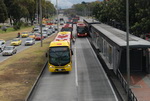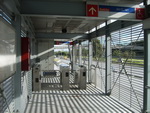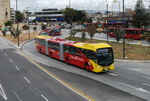TransMilenio in Bogota
 Transmilenio - Bogota
Transmilenio - Bogota
TransMilenio is a bus system with dedicated bus lanes which run through Bogota. It is copied from the system in Curitiba Brazil.
History
In 1988, transportation in Bogota was described as:
-
Slow; average time was 1 hour and 10 minutes to get anywhere.
-
Inefficient; long routes, low occupancy rates and old buses.
-
Inequality; 95% of the 1 million vehicles transporting only 17% of the population.
-
Pollution; 70% of air pollution in Bogota came from the vehicles.
-
Dangerous; by the large number of vehicles there is a high risk of accidents.
There were a number of measures. Pedestrian areas have been improved, 300 kilometers of bike paths were constructed, higher parking fees. But the main rule was that a law license plates, on certain days the use of private vehicles was blocked based on your license plate. Also they started to develop a mass transport system, Transmilenio.
What is Transmilenio?
 Transmilenio - Bogota
Transmilenio - Bogota
TransMilenio is a BRT system. BRT stands for Bus Rapid Transit (Bus Rapid Transport). It had a number of spearheads. It had quality and consistency bring affordable, fewer accidents, save time and be available to all sections of the population (young, old).
Starting Transmilenio!
In 1998 the system launched. The first year the system had to defend itself because of problems with payment cards (Mifare). But air pollution has dropped by 40%, On Places with buses, the number of accidents decreased by 90%. The average travel time has decreased by 32%. The cost of the trip is around 1500 pesos.
Future
 Transmilenio - Bogota
Transmilenio - Bogota
The bus system is still under expansion. Because of the tremendous interest on some routes buses with a capacity of 270 people has already run around instead of the normal 160. The interest and full stops and buses have also provided a side effect of pickpockets.
Operating Transmilenio
Normal Transmilenio buses are red. That drive in a closed 2-lane road in the middle of the street. Every 500 meters there are normal stations where you can board. At the beginning and end of the red bus routes are so-called feeder stations. Here the green feeder buses get together and people can move from a green to red bus or vice versa. There need to be paid only 1 time the switch is free.